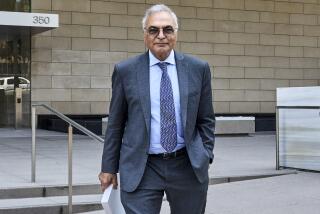Man Who Had Shiley Valve Removed Claims Device Was Already Failing : Health: Revised suit says that life-threatening fracture was discovered only after his cardiologist insisted valve be replaced.
SANTA ANA — A 44-year-old Huntington Beach man who recently had his Shiley heart valve removed has revised his lawsuit against the manufacturer after discovering that the device had begun to fracture at the time of his surgery.
Richard B. Thomas, a plant supervisor at a flour mill in Los Angeles, had the Shiley valve removed a year ago. Cardiologist Alan Edmiston, alarmed by the publicity surrounding potential defects in the valve, had urged him to have the device replaced, even though there was no indication that it was faulty.
About 50,000 people worldwide are implanted with the convexo-concave valves, made between 1979 and 1986 by Shiley Inc. in Irvine. About 300 people have died when the struts holding the valves together came apart.
After Thomas’ surgery, Henry Piehler, a metallurgist at the Carnegie-Mellon Institute in Pittsburgh, discovered that the struts had already started to fracture. He had been sent the device for examination.
“It was still intact, but it was only a matter of time before it snapped,” said James Capretz, an Irvine lawyer whose firm represents Thomas.
At the time, Thomas had already filed a suit in Orange County Superior Court against Shiley and its parent company, Pfizer Inc. in New York, seeking punitive damages for fraud and the emotional distress over the possibility that the device would fail.
A revised suit recently filed in Orange County Superior Court widened Thomas’ allegations to include product liability. It seeks damages for the cost of valve replacement surgery as well as the pain and suffering that Thomas experienced during the operation. A trial date has not been set.
“The presence of an actual fracture elevates the seriousness of the case to a much higher plane,” Capretz said. “Because the valve had already fractured, serious injury or death, in our view, was imminent.”
Shiley officials said that they do not comment on individual cases.
Thomas discovered in 1984 that he had congenital heart disease and that his mitral valve was deteriorating. He had it replaced with a Bjork-Shiley valve. That, in turn, was replaced in April at St. Vincent Hospital in Los Angeles.
Last year, a federal judge in Cincinnati approved a $215-million class-action settlement for Shiley recipients. An independent panel of experts is to set up guidelines that will determine whether recipients needed operations to replace their valves. Shiley is to pay for any needed operations. That judgment, however, is now being appealed.
Thomas was among the recipients who opted not to take part in the settlement and instead to pursue claims of emotional distress. The first of those cases is scheduled for trial in Superior Court in Santa Ana on July 15. A trial date for Thomas’ claim has not been set.
Since last fall, a research team at William Beaumont Hospital in Royal Oak, Mich., has been experimenting with a computer-assisted X-ray imaging technique that would evaluate whether a valve shows signs of strut fracture. As of Feb. 1, researchers identified five valves suspected of fracture. All five recipients had their valves replaced, but researchers discovered that one recipient’s valve was still intact.
In another case, a patient whose valve, according to the X-ray technique, was intact later died when the device malfunctioned. Shiley officials are still studying that case. Researchers do not know if the X-ray technique failed or if a fracture in the device developed after the patient was examined.
“What we’ve learned indicates that caution is still warranted before considering whether to make this procedure available to additional patients with (convexo-concave) valves outside this study,” Philip Hedger, president of the Shiley Heart Valve Research Center, said in a statement.
More to Read
Sign up for Essential California
The most important California stories and recommendations in your inbox every morning.
You may occasionally receive promotional content from the Los Angeles Times.









